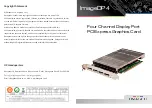
XRT86VL38
PRELIMINARY
xr
OCTAL T1/E1/J1 FRAMER/LIU COMBO
REV. P1.0.6
301
Determine the Framer(s) Requesting the Interrupt
If the interrupting device turns out to be the Framer, then the microprocessor must determine which of the four framer chan-
nels requested the interrupt. Hence, upon reaching this state, one of the very first things that the microprocessor must do
within the user Framer interrupt service routine, is to perform a read of each of the Block Interrupt Status Registers within all
of the Framer channels that have been enabled for Interrupt Generation via their respective Interrupt Control Registers.
Table 179 lists the Address for the Block Interrupt Status Registers associated with each of the Framer channels within the
Framer.
The bit-format of each of these Block Interrupt Status Registers is listed below.
For a given Framer, the Block Interrupt Status Register presents the “Interrupt Request” status of each “Interrupt Block”
within the Framer. The purpose of the “Block Interrupt Status Register” is to help the microprocessor identify which “Inter-
rupt Block(s) have requested the interrupt. Whichever bit(s) are asserted, in this register, identifies which block(s) have ex-
perienced an “interrupt generating” condition. Once the microprocessor has read this register, it can determine which
“branch” within the interrupt service routine that it must follow; in order to properly service this interrupt.
The Framer IC further supports the “Interrupt Block” Hierarchy by providing the “Block Interrupt Enable Register. The bit-
format of this register is identical to that for the “Block Interrupt Status Register”, and is presented below for the sake of
completeness.
T
ABLE
179: A
DDRESS
OF
THE
B
LOCK
I
NTERRUPT
S
TATUS
R
EGISTERS
F
RAMER
N
UMBER
A
DDRESS
OF
B
LOCK
I
NTERRUPT
S
TATUS
R
EGISTER
0
0x0B02
1
0x1B02
2
0x2B02
3
0x3B02
4
0x4B02
5
0x5B02
6
0x6B02
7
0x7B02
















































